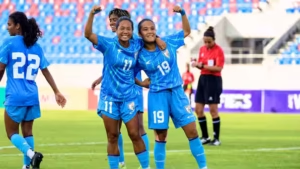The All India Football Federation (AIFF) and Football Sports Development Limited (FSDL) have once again pushed Indian football to the brink.
The failure to finalize or even issue the Indian Super League’s (ISL) commercial rights tender by the Supreme Court mandated deadline of October 15, 2025, has created a governance vacuum that threatens not just the 2025–26 season, but the credibility of Indian football’s entire commercial structure. This missed deadline isn’t a mere delay; it is a legal, operational, and financial crisis that exposes systemic weaknesses in how Indian football’s premier league is governed and financed.
The Roots of the Crisis: An Expired 15-Year Pact
The crisis originates from the impending expiry of the 15-year Master Rights Agreement (MRA) between the AIFF and FSDL, signed in 2010. The partnership gave FSDL a Reliance–Star joint venture full commercial rights to operate and market the ISL.
The MRA, worth roughly ₹450 crore, expires in December 2025, ending FSDL’s exclusive hold on India’s top-tier league. Over the past decade, FSDL’s backing helped professionalize Indian football’s commercial front but also concentrated financial power in one entity, leaving the AIFF and clubs heavily dependent on it for survival. Negotiations to renew the deal turned contentious this year. FSDL wanted a long-term extension for business continuity and to recover losses it claims to have incurred. The AIFF, however, was under judicial and constitutional scrutiny following governance disputes, which stalled its ability to sign new contracts.
That deadlock led the Supreme Court to intervene in April 2025, instructing both AIFF and FSDL to present a joint roadmap that would ensure continuity of Indian football.
The Supreme Court’s Mandate
In August 2025, both parties submitted a joint resolution. The Supreme Court approved a framework mandating a competitive, transparent tender process to identify the new ISL commercial partner.
Key conditions included:
- Open, globally compliant tender process under FIFA/AFC and National Sports Governance Code regulations.
- Completion deadline: October 15, 2025.
- Oversight: The process to be supervised by former SC judge Justice Nageswara Rao and executed by a Big Four audit firm.
- FSDL’s waiver: Crucially, FSDL agreed to waive its Right of First Negotiation (ROFN) and Right to Match any bid a major legal concession to allow open competition.
The AIFF, therefore, had six weeks to execute a process that usually takes six to nine months in global football markets. That compressed window was a judicial necessity, not a commercial choice. Yet, even under court supervision, the AIFF failed to initiate the first step issuing the Request for Proposal (RFP).
October 15: The Deadline That Wasn’t Met
As of the mandated deadline, not only was no commercial partner finalized the tender notice itself had not been issued.

This is not procedural slippage; it’s outright judicial non-compliance. The tender was supposed to be launched in September to allow time for bids and evaluation. Instead, the AIFF only appointed KPMG as consultant on September 17, leaving barely four weeks to design, circulate, and assess a complex multi-billion-rupee rights package.
The timeline collapse now creates cascading consequences:
| Event | Planned (as per SC) | Actual (as of Oct 15) | Impact |
| Joint Resolution Submitted | Aug 28, 2025 | Aug 28, 2025 | ✔ Completed |
| RFP Issued | Mid-September | Not Issued | ❌ Major breach |
| Partner Finalized | Oct 15, 2025 | Failed | ❌ Legal risk |
| Season Kick-Off | Dec 2025 | Unlikely before Jan 2026 | ⚠️ Disruption |
This inaction not only undermines the Supreme Court’s directive but could legally reopen FSDL’s waived rights. By failing to uphold the conditions tied to its waiver, the AIFF has exposed itself to the possibility of FSDL reclaiming its exclusive commercial control, reversing the very purpose of the judicial process.
Clubs on the Edge: Financial Collapse Looms
For ISL clubs, the consequences are immediate and severe. Most franchises operate on thin margins, dependent on revenue disbursements tied to broadcast deals, sponsorship, and central funding. With no confirmed commercial partner, the cash flow has frozen. Several clubs, already grappling with delayed payments, have warned of operational shutdowns if clarity doesn’t emerge within weeks. Without a tender outcome, the distribution of central revenue remains uncertain, crippling recruitment, training, and logistics for the season.
This financial paralysis mirrors the pre-2014 era of Indian football, when club instability was the norm. If unresolved, it could spark an exodus of players and staff not just from ISL clubs, but from India’s entire professional pyramid.
The Legal & Commercial Domino Effect
The AIFF now faces multiple levels of risk:
- Judicial Risk: The Supreme Court is expected to demand immediate explanations. Non-compliance with its mandate could invite contempt proceedings or a reassertion of judicial oversight tightening control over AIFF’s operations.
- Contractual Risk: FSDL could legally argue that the tender failure invalidates its earlier waiver, restoring its right to negotiate exclusively. This would return Indian football to the pre-resolution deadlock, undermining transparency and competition.
- Commercial Risk: The failure erodes confidence among potential global bidders. Major sports marketing agencies typically require months of due diligence; a rushed process now limits bidder quality and value, leading to underpriced bids or defaulting to FSDL under pressure.
- Operational Risk: With broadcasters and sponsors yet to receive clarity, production schedules and ad sales windows are collapsing. The planned December 2025 ISL kickoff is no longer feasible even a January 2026 start is uncertain.
The Wider Fallout: From FIFA to the Dressing Room
The timing could not be worse. FIFA and the Asian Football Confederation (AFC) have set an October 30 deadline for AIFF to finalize its new constitution. If the federation misses that as well, India risks suspension which would bar its clubs from continental competitions like the AFC Champions League 2.
Such an outcome would decimate the league’s sporting and commercial credibility. The national team’s Asian Cup preparation would also suffer, with players deprived of high-level domestic competition in the absence of an active ISL season. At the player level, uncertainty has already led to contract hesitations and deferred payments. Agents report growing concern among foreign players and coaches, some of whom are seeking exit clauses in anticipation of season delays.
The Rescue Path: 45 Days to Save the Season, despite the chaos, there remains a narrow path forward though it will require judicial intervention and executive urgency.
1. Emergency Supreme Court Hearing: The AIFF must immediately seek an emergency hearing to present a revised action plan. The Court should enhance the authority of its appointed monitor, Justice Nageswara Rao, to oversee the process directly with enforceable weekly milestones.
2. Accelerated 45-Day Tender: The only realistic window now is a 45-day rescue tender, with the RFP launched by mid-October and finalized by end-November. Bidders must be pre-qualified by KPMG to ensure financial and technical capability. Alternatively, if the process fails to attract credible bidders, the AIFF may have to negotiate a short-term (1–2 season) extension with FSDL a move that would restore stability but risk contradicting the Supreme Court’s directive.
3. Financial Relief for Clubs: AIFF must immediately utilize the pending ₹12.5 crore advance from FSDL to support financially distressed clubs, preventing defaults on player salaries and operational expenses.
4. Calendar Realignment: The ISL season must be officially postponed to January 2026, providing time for tender completion, broadcast alignment, and logistical readiness.
Long-Term Fix: Governance, Not Firefighting
The tender crisis underscores a deeper issue, AIFF’s structural incapacity to manage commercial processes independently. The solution lies in depoliticized governance and professional oversight.

India needs an Independent Commercial Board (ICB) within the AIFF staffed by experts in finance, law, and sports management, operating separately from the federation’s executive body. This board would manage all commercial assets, ensuring accountability and compliance with global best practices. Furthermore, the AIFF should adopt a multi-stream commercial model separating broadcast, sponsorship, and digital data rights to reduce dependency on a single private entity, a vulnerability exposed by the current impasse.
The October 15 failure is not merely an administrative lapse it is a governance breakdown that has paralyzed Indian football’s most valuable property. Without swift, transparent action, the AIFF risks losing not just a season, but the confidence of its stakeholders, fans, and players.
The next 45 days will decide whether Indian football restores stability or sinks deeper into institutional crisis.
In the words of a senior club executive: “We’ve built stadiums, academies, and careers on this league. But without governance, it all comes crashing down.”
Indian football stands at a crossroads once again and this time, the ball is not at the players’ feet, but in the court’s.
How useful was this post?
Click on a star to rate it!
Average rating 0 / 5. Vote count: 0
No votes so far! Be the first to rate this post.






